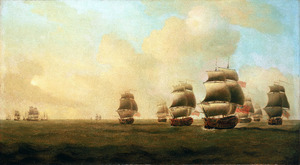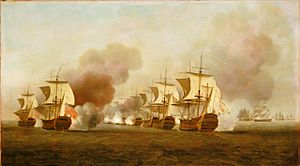HMS Cornwall (1692) facts for kids

The beginning of Knowles' action off Havana, 1 October 1748, the nearest ship (here) is the Cornwall leading the line, painting by Samuel Scott (painter)
|
|
Quick facts for kids History |
|
|---|---|
| Name | HMS Cornwall |
| Namesake | Cornwall |
| Ordered | 12 March 1691 |
| Builder | Winter, Southampton |
| Launched | 23 April 1692 |
| Commissioned | 1692 |
| Fate | Broken up, 1761 |
| Notes |
|
| General characteristics (as built) | |
| Class and type | 80-gun, third rate ship of the line |
| Tons burthen | 1,18631⁄94 (bm) |
| Length | 156 ft 4 in (47.7 m) (gundeck) |
| Beam | 41 ft 5 in (12.6 m) |
| Depth of hold | 17 ft 3 in (5.3 m) |
| Sail plan | Full-rigged ship |
| Complement | 476–520 |
| Armament | 80 guns of various weights of shot |
| General characteristics (after 1706 rebuild) | |
| Class and type | 80-gun third rate ship of the line |
| Tons burthen | 1,24121⁄94 (bm) |
| Length | 156 ft 7.5 in (47.7 m) (gundeck) |
| Beam | 42 ft 8.25 in (13.0 m) |
| Depth of hold | 17 ft 7 in (5.4 m) |
| Sail plan | Full-rigged ship |
| Armament | 80 guns of various weights of shot |
| General characteristics (after 1726 rebuild) | |
| Class and type | 1719 Establishment 80-gun third rate ship of the line |
| Tons burthen | 1,350 (bm) |
| Length | 158 ft (48.2 m) (gundeck) |
| Beam | 44 ft 6 in (13.6 m) |
| Depth of hold | 18 ft 2 in (5.5 m) |
| Sail plan | Full-rigged ship |
| Armament |
|
HMS Cornwall was a powerful warship built for the Royal Navy in the 1690s. She was an 80-gun ship of the line, which meant she was a large sailing ship designed for naval battles. Cornwall played a part in important conflicts like the War of the Grand Alliance, where she fought in the famous Battle of Barfleur and the action at La Hougue during her very first year.
Contents
About the Ship
Cornwall was a big ship for her time. She was about 47.6 meters (156 feet) long on her main gun deck. Her widest part, called the beam, was about 12.6 meters (41 feet) across. The ship was designed to carry a lot of cannons, with 80 guns in total. These guns were placed on different levels, or decks, of the ship. She needed a large crew, usually between 476 and 520 sailors and officers, to operate her effectively.
Over her long life, Cornwall was rebuilt several times. Each rebuild updated her design and sometimes her size or the types of guns she carried. This was common for warships back then, as technology and naval needs changed.
Building and Service History
Cornwall was the very first ship in the Royal Navy to be named after the county of Cornwall in England. She was ordered in March 1691 and built by John Winter in Southampton. The ship was officially launched on April 28, 1692, ready to join the fleet.
Early Years and Rebuilds
After her first launch, Cornwall was rebuilt between 1705 and 1706 in Rotherhithe. This was a major overhaul to keep her strong and up-to-date. After this rebuild, she sailed to the Mediterranean. There, during the War of the Spanish Succession, she helped capture a French convoy (a group of ships traveling together for protection) off Catalonia in May 1708.
Later, in January 1722, Cornwall was ordered to be taken apart and rebuilt again. This time, the work was done at Deptford, following new design standards from 1719. She was relaunched on October 17, 1726, still as an 80-gun ship.
Later Service and Final Days
After her second rebuild, Cornwall spent time serving in peaceful areas like the Baltic and Mediterranean. She wasn't used in active combat again until 1742, even though a war, the War of the Austrian Succession, had started in 1739.
Cornwall first served off the coast of Spain. Later, she was sent to the West Indies. In March 1748, she helped capture Fort Saint Louis de Sud in the French colony of Haiti. In October 1749, she had an important moment when she captured a 64-gun Spanish frigate while protecting a convoy near Havana.
By 1755, Cornwall was no longer used as a fighting ship. Instead, she became a prison ship, holding prisoners. Her long career ended in 1760, and she was finally broken up in 1761.


